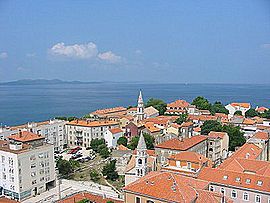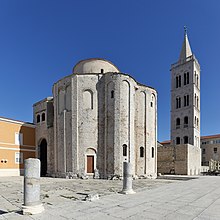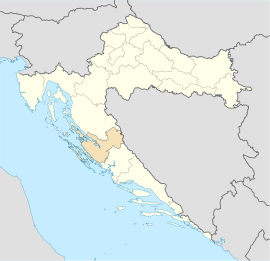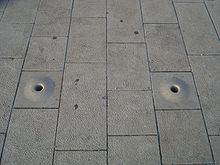Zadar
| Zadar | |||
|
|||
|
|
|||
| Basic data | |||
|---|---|---|---|
| State : |
|
||
| County : |
|
||
| Height : | 0 m. i. J. | ||
| Area : | 194 km² | ||
| Residents : | 75,062 (2011) | ||
| Population density : | 387 inhabitants per km² | ||
| Telephone code : | (+385) 023 | ||
| Postal code : | 23,000 | ||
| License plate : | ZD | ||
| Boat registration : | ZD | ||
| Structure and administration (as of 2019) |
|||
| Community type : | city | ||
| Structure : | 15 districts | ||
| Mayor : | Branko Dukić ( HDZ ) | ||
| Coalition partner : | HSP AS, HSU, HRAST, REFORMISTI | ||
| Postal address : | Narodni trg 1 23 000 Zadar |
||
| Website : | |||
| Others | |||
| Patron saint : |
St. Simeon (Sv.Simun), St. Chrysogonus (Sv. Krševan), St. Anastasia (Sv.Stošija), St. Zoilus (Sv. Zoilo) |
||
| City Festival : |
November 24th (Chrysogonus), January 15th (Anastasia) |
||
 View of Zadar |
|||
The city of Zadar [ ˈzadar ] ( Italian Zara ) is located in southern Croatia in northern Dalmatia . Zadar is a port city and a seaside resort on the Adriatic with 75,062 inhabitants (2011).
Zadar is the administrative seat of the Zadar County ( Croatian Zadarska županija ), seat of the Catholic Archdiocese of Zadar . Zadar is also the seat of a university founded in 2003 .
The urban area also includes the 14 villages Babindub , Brgulje , Crno , Ist , Kožino , Mali Iž , Molat , Olib , Petrčane , Premuda , Rava , Silba , Veli Iž and Zapuntel .
history
Zadar was already a settlement and main trading place of Liburnia in Illyrian times. In Roman sources it is mentioned as Iader or Iadera (in German also Jadera ), by Konstantinos Porphyrogennetos in the 10th century as Diadora .
In the 2nd century BC The Romans subjugated the city, built a capitol , fortifications, thermal baths and an aqueduct . After 59 BC Zadar was a Roman municipality , from 48 BC. A colony of Roman citizens. After the fall of the Western Roman Empire , Zadar became the capital of the Byzantine theme of Dalmatia . From then on the rulers of the city changed: first Frankish , at the beginning of the 9th century Byzantine. As a result of the looting by pirates, Zadar came under Venetian protection around 1000 and was formally ceded by the Eastern Roman Emperor Alexios I. In 1018 the city again placed itself under Venetian protection.

In the 11th century, Croatian rulers held the actual rule over the city. In 1069 Zadar came to Croatia for the first time (?) Under King Petar Krešimir IV . In 1102 Croatia and thus also Zadar came to Hungary through an agreement ( Pacta conventa ) in personal union. From the beginning of the 12th century, the city was attacked several times by the Republic of Venice . Here in 1118 the troops of the Hungarian-Croatian King Stephen II triumphed over the Venetians. Ordelafo Faliero , the Doge of Venice , found his death in front of the city on this occasion. In 1202 Zadar was first besieged and finally conquered by the Venetians with the help of a primarily French crusader army .

The Venetian and Croatian-Hungarian periods of rule now alternated. After several uprisings (so in the years 1242-1247 and 1345-1346 ), Zadar came into the possession of the Hungarian-Croatian King Ludwig I ( Peace of Zadar , 1358). After his death, King Sigismund ruled , then Ladislaus of Naples , pretender to the Hungarian crown. In 1409 he sold Zadar and his rights to Dalmatia to Venice for 100,000 ducats .
The securing of the city began now, as the Venetians took over the political and economic protection of the city. When the Ottomans conquered the hinterland at the beginning of the 16th century, the city was developed into a strong fortress by the Venetians, which secured Venetian trade on the Adriatic and served as the administrative center for the Venetian possessions in Dalmatia. The Venetian fortress was added to the UNESCO World Heritage List in 2017 as part of the entry “ Venetian Defense System of the 16th to 17th Centuries ” . Zadar was until 1797 the capital of the Venetian double province Dalmazia e Albania .
After the fall of Venice in 1797, Zadar came to Austria . The city had to cede the latter to the French Empire in 1805 , which it proposed to the Illyrian provinces . During the French rule, the first newspaper in Croatian appeared in Zadar , the Kraljski Dalmatin (1806-1810).
In December 1813, after a six-day bombardment, Zadar returned to Austria by surrender, and it remained in Austria's possession until 1918. It was the capital of the Kingdom of Dalmatia , which was one of the Austrian crown lands. In the second half of the 19th century, Zadar was a center of the Croatian cultural and national rebirth movement in Dalmatia, which actually represented the first nation -building in which certain terms only emerged. From 1838 the Srpsko-dalmatinski magazine and from 1844 the literary magazine Zora dalmatinska appeared here . From 1862 the newspaper Il Nazionale was published twice a week , once a week with the supplement Prilog k Narodnom listu in Croatian. It was the newspaper of the Narodnjaci ( German about "the National"), who pleaded for a merger of Dalmatia with the Kingdom of Croatia and Slavonia . In the same year the Matica dalmatinska , a Slavic cultural association based on the model of Matica srpska and Matica hrvatska , was founded in Zadar . In 1863 the Slavjanska čitaonica was opened in the city , a reading room that was also the meeting place of the Narodnjaci in the Dalmatian state parliament (sabor) .
Until the First World War , Zadar was a garrison town of the Austro-Hungarian Army . The staff as well as the I. and III. Battalion of Landwehr - Infantry - Regiment Nr. 23.
After the First World War, Zadar fell to Italy through the Rapallo Border Treaty (1920) . During the Second World War, the coastal city was the target of violent Allied air strikes, which caused severe damage to the historic sites. In 1945/47 the city became part of the Republic of Croatia within Yugoslavia . The largely Italian-speaking population then almost completely left the city for Italy (see Foibe massacre ). Zadar has been part of the independent Republic of Croatia since 1991 and is increasingly becoming one of the most important Adriatic sea ports. In addition to many other religious orders, the Order of the Carmelites is also represented in Zadar .
In 1991 the Yugoslav People's Army attacked Zadar from the air and with artillery during the war in Croatia and also caused numerous damage to cultural assets. The city could then only be defended against the advancing troops with great effort. Traffic with Zagreb could only be maintained via the island of Pag . The siege of the city lasted until January 22, 1993, when the Croatian army re-established the connection between Zadar and the Maslenica area and Zagreb. In 1995, the operation of Oluja restored sovereignty throughout the hinterland.
heritage Site
Zadar, located on a narrow headland on the Adriatic Sea and on the Zadar Channel , is separated from the mainland by a moat. Zadar was a fortress until 1873. The city has a large port , four gates (including the naval gate with an inserted part of a Roman triumphal arch and the Porta di Terraferma built according to the design of Sanmicheli ). Most of the old town of Zadar is of the Venetian style. Among the squares are the Herrenplatz with the main guard building and the Gradska Straža (with the city library) as well as the fountain square with an ancient Corinthian column. One of these also adorns Simeonsplatz .

Churches of cultural and historical importance are:
- The cathedral church of St. Anastasia (Croat. Sveti Stošija ) was built from the 12th to the 13th century; the apse of a previous church from the 9th century was preserved. The facade , decorated with blind arcades and two rosettes, contains three late Romanesque portals. In the tympanum of the main portal the relief "Mother of God with Child and Saints" from 1324 can be seen. The free-standing bell tower was built next to the three-aisled basilica in the 14th century. The interior houses the marble sarcophagus of Saint Anastasia from the 9th century, fresco fragments from the 13th century, an early Gothic ciborium from 1332, Romanesque stone tablets and marble benches, a winged altar and carved choir stalls from the 15th century, a round baptistery and valuable paintings . The crypt was built under the chancel in the 12th century .
- The Church of Saint Donatus ( Crkva svetoga Donata ) was built in the 9th century.
- Saint Chrysogonus ( Sveti Krševan ) was built in 1175 instead of a church from the 6th century as a three-aisled basilica with three apses divided by blind arcades and ornamental galleries. Here Ladislaus of Naples was crowned King of Hungary and Croatia in 1403. The pillars inside have ancient capitals . In the side apses there are frescoes from the 13th-14th centuries. Century preserved.
- The first St. Mary's Church (Sveti Marija) was consecrated as part of the Benedictine monastery as early as 1091 . The current building dates back to the 16th century and contains elements of Gothic and Renaissance styles . The interior is baroque with rich stucco work and a statue of the Madonna from the 15th century. On the first floor of the Romanesque bell tower there is a chapel with remains of frescoes from the 12th century.
- The former church of the Holy Trinity to be the oldest of the city, according to legend from the rubble of a Junotempels in the 9th century have been built. It is now an ancient museum.
- The Franciscan Church was built in Gothic style in 1283, but mostly rebuilt in the 18th century. The single-nave church contains valuable paintings. In the treasury there is a painted Romanesque crucifix from the 12th century. The Renaissance cloister was built in 1556.
- The Simeon Church (Sv. Šimun) from the 16th and 17th centuries contains the ornate reliquary of St. Simeon .
- The Orthodox Elias Church was built in 1773 in the late baroque style. Inside are valuable icons from the 16th to 18th centuries. Century kept.

Other notable structures are:
- the roman forum,
- the former palace of the priors,
- the archbishop's palace,
- the arsenal as well
- the “five fountains” and the adjacent “tower of the city commandant”: The square was built in 1574 over a cistern. The wells supplied the city with water until the middle of the 19th century.
tourism
In March 1902, the city's first hotel, Hotel Bristol (now Hotel Zagreb ) opened. Around Zadar there are five national parks: the National Park Krka , the National Park Paklenica , the Northern Velebit National Park , National Park Kornati and the Plitvice Lakes National Park .
climate
| Zadar | ||||||||||||||||||||||||||||||||||||||||||||||||
|---|---|---|---|---|---|---|---|---|---|---|---|---|---|---|---|---|---|---|---|---|---|---|---|---|---|---|---|---|---|---|---|---|---|---|---|---|---|---|---|---|---|---|---|---|---|---|---|---|
| Climate diagram | ||||||||||||||||||||||||||||||||||||||||||||||||
| ||||||||||||||||||||||||||||||||||||||||||||||||
|
Average monthly temperatures and rainfall for Zadar
Source: The climate in Zadar
|
|||||||||||||||||||||||||||||||||||||||||||||||||||||||||||||||||||||||||||||||||||||||||||||||||||||||||
Town twinning
Zadar lists the following seven twin cities :
| city | country | since |
|---|---|---|
| Dundee |
|
2014 |
| Fürstenfeldbruck |
|
1989 |
| Banská Bystrica |
|
1995 |
| Iquique |
|
2003 |
| Padua |
|
2003 |
| Reggio nell'Emilia |
|
1972 |
| Romans-sur-Isere |
|
1985 |
| Székesfehérvár |
|
1997 |
Sports
The sport in Zadar is particularly characterized by basketball : KK Zadar is a traditional club that has also participated in European tournaments in the past. In addition to KK Zadar, the smaller club KK Borik also plays in the first Croatian league. The multi-purpose hall Dvorana Krešimira Ćosića , which was built on the occasion of the men's handball world championship in 2009 , serves as the home ground of the KK Zadar.
There are also two cycling clubs: BK Zadar and BK Donat. Both are dedicated to road racing and actively care for younger cyclists. Traditionally, the BK Zadar organize the “1. May street race "and the BK Donat the z. T. tourist bike tours Plitvice-Zadar (early summer) and Knin-Zadar (August 5th).
The city football club NK Zadar plays in the 2nd Croatian league (2nd HNL) in the 2019/20 season, but is increasingly struggling with financial problems.
traffic
Zadar is very well connected to the Croatian road network. The European route 65 (also Croatian national road 8, Državna cesta D8 ) leads directly through the eastern part of the city and ensures a connection with coastal cities such as Rijeka , Šibenik or Split . In addition, Zadar is also connected to the newly built motorway 1 via the Posedarije , Zadar 1 and Zadar 2 exits .
Zadar also has a ferry port from which connections to the offshore islands and Italy are offered. The Zadar airport is the international airport of the city. In addition to regional destinations, various European cities are also served from here.
Rail transport is of minor importance. The city is the end of the Knin – Zadar railway line . Three pairs of regional trains run to and from Knin every day .
Art objects worth seeing
Since July 2005 there has been a sea organ created by the architect Nikola Bašić at the harbor , which generates music through the movement of the waves. The sea waves press air into the organ pipes, producing different tones depending on the wave speed and pipe size.
In 2008, the same architect installed a 22-meter circle made of 300 multi-layered, accessible glass panels in the immediate vicinity. The solar cells underneath catch the sunlight, which creates colorful plays of light at sunset.
Coat of arms and city saints
The coat of arms shows St. Chrysogonus (sveti Krševan) ; however, today St. Anastasia (sveta Stošija) . The text of the song “Zadar Grad u moru” also names St. Bishop Donat , St. Simeon , St. Francis of Assisi (sveti Frane) and Our Lady .
Personalities
The following people were born in Zadar or come from Zadar:
- Jelena of Zadar († 976), Queen of Croatia (wife of King Mihajlo Krešimir II.)
- Jacob of Zadar (≈1400–1490), beatified Franciscan
- Francesco Laurana (1430–1502), sculptor and architect
- Petar Zoranić (1508–1543/69), writer
- Florian von Macchio (1802–1895), Austrian officer, field marshal lieutenant
- Franz von Suppè (1819–1895), composer
- Ludwig Rubelli von Sturmfest (1842–1905), marine painter
- Alfred Krauss (1862–1938), infantry general in the Austro-Hungarian army
- Felix Weingartner (1863–1942), composer
- Kamilo Tončić-Sorinj (1878–1961), Austrian-Yugoslav architect and museum director
- Georg Ludwig von Trapp (1880–1947), KuK submarine commander and father of the "singing Trapp family"
- Josip Rela (1895–1966), teacher, director and author
- Mate Solis (1935–2019), painter, sculptor and illustrator
- Stelvio Mestrovich (* 1948), Italian writer, poet and critic
- Edo Zanki (1952–2019), musician and producer
- Tomislav Ivčić (1953–1993), singer and composer
- Darko Anić (* 1957), Croatian-French chess grandmaster
- Emilija Kokić (* 1968), singer
- Zoran Primorac (* 1969), table tennis player
- Dado Pršo (* 1974), football player
- Branimir Longin (born 1978), basketball player
- Saša Bjelanović (* 1979), football player
- Marijan Buljat (* 1981), football player
- Roman Simić (* 1972), Croatian writer
- Tanja Stupar Trifunović (* 1977), author, poet and editor-in-chief
- Hrvoje Ćustić (1983–2008), football player
- Natali Dizdar (* 1984), singer
- Luka Modrić (* 1985), football player
- Igor Banović (* 1987), football player
- Marin Tomasov (* 1987), football player
- Doris Pinčić (* 1988), actress
- Stipe Žunić (* 1990), shot putter
- Šime Vrsaljko (* 1992), football player
- Josip Majić (* 1994), football player
- Bernarda Pera (* 1994), American tennis player
- Dominik Livaković (* 1995), football player
gallery
Bust relic of Pope Sixtus I in the permanent exhibition "Gold and Silver of Zadar" in the Church of St. Mary
Web links
- Official website of the city of Zadar (Croatian)
- Zadar / Zara: Historical postcards (Italian)
literature
- Franz N. Mehling (Ed.): Knaurs Kulturführer: Yugoslavia . Droemer Knaur Munich / Zurich 1984, pp. 420–24, ISBN 3-426-26135-9 .
Individual evidence
- ↑ cf. Map under Austria-Hungary # Dual Monarchy 1867–1914
- ^ Antoni Cetnarowicz: The national movement in Dalmatia in the 19th century. From "Slavism" to the modern Croatian and Serbian national idea. Peter Lang, Frankfurt am Main 2008, ISBN 978-3-631-57418-8 , p. 23 and 73.
- ^ Peace treaty with Italy , Article 11.
- ↑ Povelje o prijateljstvu - MEDUNARODNA suradnja | degree Zadar - Gradska uprava. Retrieved September 28, 2015 .
- ↑ Timetable
- ↑ ZADAR Sea Organ , on www.lotos-croatia.com , accessed on December 24, 2010.





























